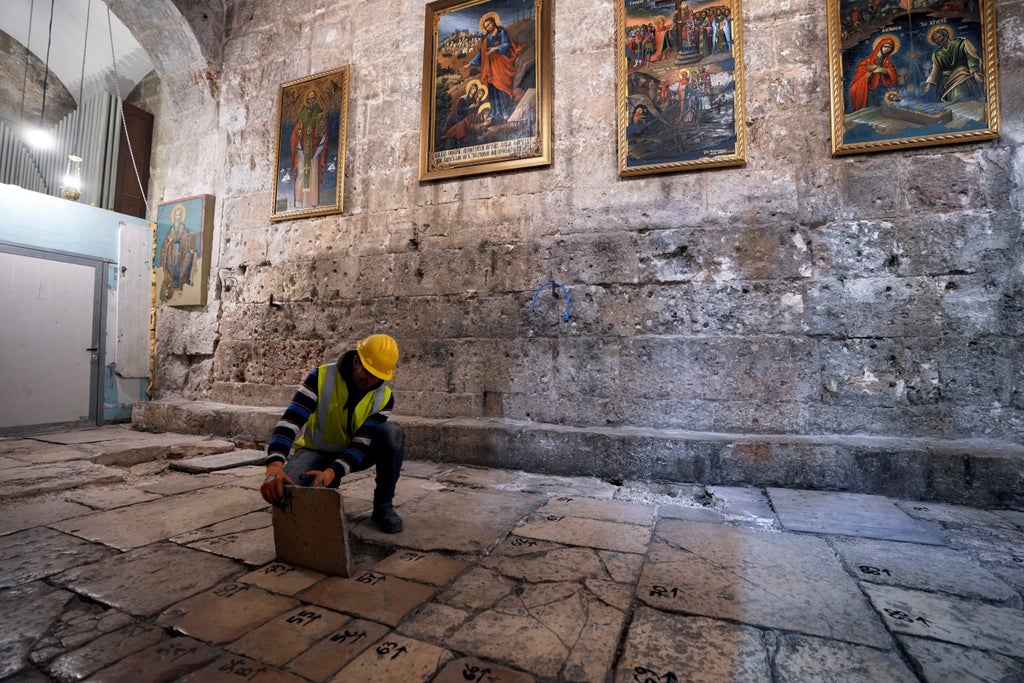
The three Christian communities that have uneasily shared their holiest site for centuries are embarking on a large-scale project to restore the ancient stone floor of the Jerusalem basilica.
The project includes an excavation that could shed light on the rich history of the Church of the Holy Sepulchre in the Old City, built on the site where Christians believe Jesus was crucified, died and rose again, the central event of the faith celebrated every spring on Easter.
It marks a further improvement of ties among the Catholic, Greek Orthodox and Armenian Apostolic churches. In the past, they have come to blows over the site, which they share under a delicate arrangement dating back to the mid-19th century. Three other denominations also have clearly defined access to the church.
“The cooperation among the three communities is the most important thing," said Rev. Francesco Patton, the head of the Catholic Franciscan order devoted to preserving Christian sites in the Holy Land. “It shows to the entire world that it is possible among Christians of different churches and communities to have a fraternal relationship."
The three communities came together in 2016 to restore the Holy Edicule on the site where Jesus is believed to have been buried in a cave tomb — the first large-scale renovation since the clean-up after an 1808 fire.
The renovation of the Edicule pointed to the need for further repairs of the floor of the basilica, which includes stones from the Crusader era in the 12th century, recent additions from the 19th century and splotches of concrete and mortar, part of earlier and cruder renovations. The 1,200 square-meter (13,000 square feet) floor will be repaired in phases to allow liturgical services and visits to continue.
The sewage and electricity lines running beneath the church, which is nestled in the heart of Jerusalem's densely populated Old City, will also be repaired.
Heading up the project is Osama Hamdan, a Palestinian Muslim architect from Jerusalem who has worked on the conservation of Jewish, Christian and Muslim sites across the Holy Land. He said it's a great honor to work at the church, which he sees as part of his own cultural heritage.
“It’s a big part of the history of this territory, and we are the results of this accumulation of cultures," he said. "Before (we were) Muslims, we were Christians, and before we were Jewish, and before we were pagans.”
At a ceremony marking the start of the project, the Greek patriarch of Jerusalem, Theophilos III, acknowledged that it was a “difficult time for humanity,” with war raging in Ukraine and instability elsewhere.
“As we care for and restore this holy place, we participate in the message of hope that emanates from the holy tomb not just for the Christians, but also for people of goodwill around the world,” he said.
After a preliminary study carried out over the past two years, when the church was largely empty because of the coronavirus pandemic, work began this month. The $11 million renovation project will be funded through donations and is expected to be completed in May 2024 — depending on what the archaeologists find.
The archaeological work will be undertaken by experts from the Sapienza University of Rome in coordination with the Franciscan Faculty of Biblical Sciences and Archaeology in Jerusalem.
“When you are doing some archaeological excavations you always expect to have some surprise," Patton said.
Christian tradition holds that Jesus was crucified by the Romans just outside the city's walls as they existed 2,000 years ago, and was buried in a cave tomb nearby. The Romans persecuted the early Christian community, and Emperor Hadrian built pagan temples on the site.
After Emperor Constantine embraced Christianity in the 4th century, his mother, Helena, traveled to the Holy Land to identify sites linked to Jesus and commissioned monumental churches, including a sprawling basilica on the traditional location of the crucifixion and burial.
That structure was torched by Persian invaders in 614 and destroyed again in 1009 by the psychopathic caliph al-Hakim, who persecuted Jews, Christians and even fellow Muslims. A 12th-century restoration by the Crusaders gave the Church of the Holy Sepulchre its current appearance.
Since 1852, the site has been governed by a rigid power-sharing arrangement among the different Christian denominations known as the “status quo." A Muslim family has been entrusted with the keys to the church for at least 800 years.
Under the arrangement, the various denominations have undertaken smaller renovations of the chapels under their control, but collective action to maintain shared areas often proved elusive. A wake-up call came in 2015, when Israeli authorities briefly closed the Edicule, deeming it unsafe.
Inter-denominational relations have steadily improved since then, even as the Israeli-Palestinian conflict and other regional disputes remain as intractable as ever. The restoration work itself seems to have helped the various churches to patch up their differences.
“Dialogue is really facilitated when you are doing something together with the others," Patton said. "Working together is something that helps people to know each other and to start a process of trusting.”







